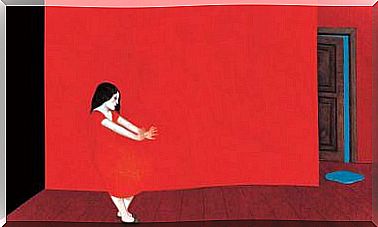Cut Off Intrusive Thoughts
There are many people who have to live with endless obsessive and intrusive thoughts that hinder their day to day and their work, social and family performance. They can be at the base of many anxiety or mood disorders.
They can also appear in personality disorders, factitious disorders, body dysmorphic disorder, among others. However, intrusive thoughts, outside of having a clinical relevance, can also affect people without any definite disorder.
These thoughts can be difficult to dismiss, intrusive at odd hours of the night, and very annoying. In this article we offer some alternatives that arise from different psychological models that can help us deal with these intrusive thoughts.
The nature of intrusive thoughts
Intrusive thoughts often have a negative nature. If we were repeating ourselves every day how capable we are, this would not be a problem. The reality is that obsessive thoughts can be disabling, as they are negative, toxic, and often unrealistic ideas.
The nature of obsessive thoughts lies in their irrationality. It is normal that, from time to time, certain ideas that concern us are more time in our head than others. However, when these ideas diminish our self-concept, cause a worse work or social performance or bring with them negative emotions, it is when we can brand them as obsessive, irrational and toxic.

What is an irrational thought?
According to psychologists Shelley Ehyno and David Clark, irrational thinking is understood to be any distinct and identifiable cognitive event that is unwanted, involuntary and recurrent. It disrupts the flow of thought, interferes with task performance, is associated with negative emotional responses, and is difficult to control.
These emotional responses can be as unpleasant as they are intense, since instead of feeling disgust, an uncontrollable rage is felt; Instead of feeling resignation and acceptance, you feel bitterness; or instead of feeling fear — which is functionally very useful — you feel terror.
Obsessive or irrational thoughts are not only characterized by giving rise to too intense an emotion, but also by being expressed in absolutist terms. This means that when elaborating the thought, adverbs such as “always”, “never”, “never”, and so on, are usually included.
Intrusive thoughts and self-imposed demands
They tend to be related to what one needs to be happy, or what one should be or know how to do. That is, they are about self-imposed demands. Also, much of the content of irrational and obsessive thoughts is not verifiable.
This means that the obsession often develops around something that is impossible for us to empirically contrast or demonstrate. This does nothing more than give power to thought itself due to the infinity of possibilities and the non-confirmation of any.
For example, a person’s obsessive thoughts may be about a college degree project. It is normal for a person to worry about the development of work, but the type of obsessive thinking that can have type:
- “I have to have it done by next week”
- “I will never approve”
- “I’m stupid and the job is badly done.”
As we can see with the previous explanation, absolute words such as “never” are used; should be used in an exacerbated way – “I have to” -; the judgments cannot be verifiable – “I will never approve” -; and there is an identification of the value of the person for his actions – if he does not approve that means that he is stupid.
Proposals from the cognitive-behavioral model
From the cognitive-behavioral model, several techniques are presented to cut off intrusive thoughts. Cognitive restructuring is a very useful technique, but difficult to apply, which would usually need a psychologist to be carried out.
In it, it is about changing obsessive and irrational thoughts for rational thoughts through Socratic dialogue. However, two techniques will be proposed that can be applied if the mechanisms of action are known, since they do not focus on changing the content of thoughts.

Junk time: you control when intrusive thoughts appear
The frustrating thing about obsessive thoughts is, logically, that the person cannot control them. This can diminish your feelings of self-efficacy and lead you to think that you have no room for action in your appearance.
Although it is true that these thoughts can come in the least expected moments, the truth is that the person can also evoke them. That is, it does have power over them, since it can make that obsessive thought come to mind, forcing it, without an intrusion in between.
This is what junk time is based on. It is proposed that the person enter his intrusive thoughts or thought loops at certain times of the day — for example, twice a day. The ultimate goal is that the person with intrusive thoughts can only obsess at those two times of the day.
Although it may seem complicated, it is possible to reduce intrusive thoughts
At first this appears as something very complicated, since, certainly, obsessions are not controlled. However, with practice, it is normal for the subject to be able to give himself those two moments of rumination about his thoughts, and then leave them behind for the rest of the day.
This technique is useful not only because — at least initially — it brings together the moments of discomfort from intrusive thoughts for only two situations a day; but also because it takes away the power of those obsessions.
It is no longer they who decide when to appear, but the subject who puts the technique into practice. Even junk time allows, among other things, intrusive thoughts to lose steam and begin their process of disappearance.
It is recommended, if this technique is to be put into practice, that no rumination period be established at night, due to the inactivity that sleeping brings and because it is more difficult to cut with the rumination moment.
Wolpe Thought Stop
The goal of this technique is, again, to decrease the frequency and duration of intrusive thoughts without changing their content or neutralizing them. That is, cognitive restructuring would not be necessary. In the thought stop, an interruption of the unwanted thought is sought and its replacement by images that make it difficult to reappear.
To practice this technique, upon receiving an intrusive thought, a word or behavior must be conditioned to the interruption of thought. The word can be “stop” or “enough” followed by a knock on the table, or if you want to do it in a more covert way, you can wear a rubber band on your wrist, which we will have to stretch every time we want to cut with that thought intrusive.
Although this technique does not work for very elaborate obsessions, it can be useful for intrusive thoughts in everyday life. It is important to practice it daily to condition the word or behavior. If not, it will be useless.
Proposals from acceptance and commitment therapy (ACT)

The ACT considers the suffering inherent in the human experience, and that current mainstream efforts to eliminate it are counterproductive. We find here the concept of experiential or experiential avoidance, where a person is not willing to have contact with their private experiences and wants to alter the form or frequency of those experiences and their contexts, in this case, intrusive thoughts.
This means that the ACT does not propose techniques to try to suppress intrusive thoughts, but rather seeks their acceptance and orientation to values beyond obsessions. Therefore, accepting is more useful than trying to suppress.
The notorious thing about ACT is that it seeks that, despite the fact that the person has intrusive thoughts, they do not detach from their values and their commitment to action. Although the suppression of intrusive thoughts is not a goal of ACT, they usually tend to decrease naturally.








